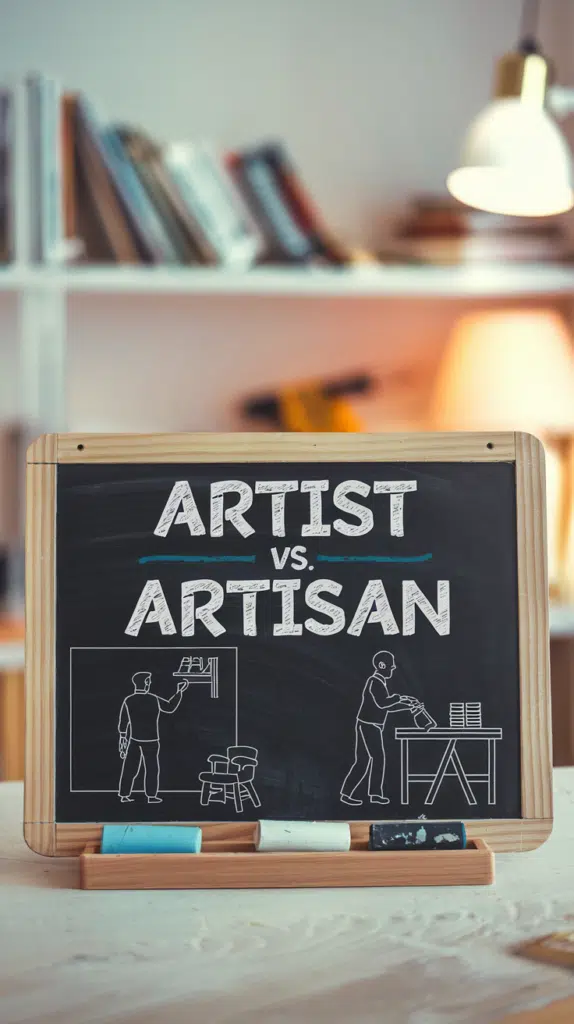Introduction
In a world rich with creativity and craftsmanship, the terms artist vs artisan often come up in discussions about creative work. While these words are sometimes used interchangeably, they embody distinct philosophies and approaches to creation.
Understanding the differences between an artist and an artisan not only enhances our appreciation for each role but also helps us navigate conversations about creativity and craftsmanship.
This article aims to provide a deep dive into the nuances of artist vs artisan, exploring definitions, key differences, etymology, and the importance of both roles in society.

like more : Plural of Chief – Grammar Beacon
Defining the Terms
What is an Artist?
An artist is typically defined as a person engaged in a creative endeavor, producing works that prioritize creative expression. Artists can work across various mediums, including painting, sculpture, music, writing,
and performance. Their primary goal is often to evoke emotions, provoke thoughts, and challenge societal norms.
For instance, consider the powerful performances of Marina Abramović, a performance artist known for her emotionally charged and often provocative works.
Through her art, she explores themes of vulnerability, endurance, and the relationship between artist and audience.
Scenario: Imagine attending an art exhibit where an artist showcases a series of paintings that reflect their personal struggles with identity. Viewers are encouraged to interact with the art, sharing their interpretations and emotions, thus creating a dialogue around the piece.
What is an Artisan?
In contrast, an artisan is a skilled craftsperson dedicated to creating handmade goods that prioritize functionality alongside aesthetics. Artisans typically have honed their skills through years of practice, often relying on traditional techniques passed down through generations.
For example, a glassblower meticulously shapes molten glass into beautiful vases and bowls, each piece reflecting both artistic flair and practical usability.
The artisan’s work often emphasizes quality craftsmanship, durability, and a strong connection to materials.
Scenario: Picture a local craft fair where an artisan demonstrates their craft. As they skillfully weave a basket, the audience watches in awe, appreciating not just the beauty of the basket but also its intended use for storage and decoration.
like more : What’s the Plural of Moose? – Grammar Beacon
Key Differences Between Artist vs Artisan
Focus: Creative Expression vs. Functionality
One of the most significant distinctions between artists vs artisans lies in their focus. Artists primarily seek creative expression, often using their work to communicate emotions, ideas, and personal narratives.
In contrast, artisans prioritize functionality, creating items designed for practical use while also incorporating artistic elements.
Example: An artist may create a striking mural that aims to inspire or provoke thought, while an artisan might design a beautifully crafted piece of furniture that enhances a living space’s aesthetic while serving a practical purpose.
Process: Intuitive Creation vs. Skillful Craftsmanship
The process of creation is another crucial differentiator between artists and artisans. Artists often engage in intuitive creation, allowing their emotions, instincts, and spontaneity to guide their work.
This process can be unpredictable and may involve experimentation with various forms and styles.
On the other hand, artisans employ skillful craftsmanship rooted in learned techniques and methods. Their creations typically involve meticulous planning, precision, and a thorough understanding of materials.
Scenario: An artist may spontaneously throw paint on a canvas to express their feelings about a recent event, while an artisan meticulously measures and cuts wood to create a custom bookshelf, ensuring every detail is perfect.

Uniqueness: Originality vs. Replicability
When discussing uniqueness, artists often strive for originality in their work. Each piece is typically one-of-a-kind, reflecting the artist’s individual style and perspective.
In contrast, artisans may create multiple versions of a single design, focusing on replicability without compromising the essence of their craft.
Example: A sculptor may produce a unique statue that embodies their personal vision, while a ceramicist might create a line of mugs, each with slight variations but adhering to a common design theme.
Materials: Mediums Used by Artists vs Artisans
The materials chosen by artists and artisans further highlight their differences. Artists frequently experiment with a wide range of mediums, from traditional paints to digital tools.
Their choice of materials often reflects their artistic intent, be it to evoke emotions or convey specific messages.
Artisans, however, typically work with traditional materials associated with their craft, such as wood, metal, clay, or textiles. Their expertise lies in manipulating these materials to create beautiful and functional objects.
Scenario: An artist might decide to use unconventional materials, like recycled items or found objects, to create a mixed-media piece, while an artisan chooses high-quality wood to construct a sturdy and aesthetically pleasing dining table.
like more : Thomas’s or Thomas’ – Grammar Beacon
Etymology: The Origins of the Terms
Origins of the Word “Artist”
The word artist traces back to the Latin term artista, which originally referred to a skilled person in a particular craft. Over time, the definition evolved to encompass those engaged in creative pursuits that focus on aesthetic expression.
The Renaissance era played a crucial role in elevating the status of artists, emphasizing individual creativity and the importance of their contributions to culture.
Origins of the Word “Artisan”
In contrast, the term artisan comes from the Latin artifex, meaning “craftsman” or “artist.” This word underscores the skill and craftsmanship involved in creating functional goods.
Historically, artisans were highly regarded for their ability to produce quality items through hands-on techniques. Many artisans belonged to guilds, organizations that ensured quality standards and provided apprenticeships to pass down skills.
Examples of Artistic Endeavors
Notable Artists and Their Work
To grasp the concept of an artist, let’s look at some notable figures:
Leonardo da Vinci: Renowned not only as a painter of masterpieces like The Last Supper but also as a scientist and inventor, da Vinci exemplified the spirit of exploration and innovation in art.
Georgia O’Keeffe: Known for her large-scale flower paintings and desert landscapes, O’Keeffe’s work expresses her deep connection to nature, showcasing her unique vision.
Prominent Artisans and Their Craft
Artisans also have made significant contributions through their skilled craftsmanship. Consider these examples:
Frank Lloyd Wright: While primarily known as an architect, Wright’s designs often blurred the lines between art and functional design. His structures are celebrated for their harmony with nature and innovative use of materials.
Sophie Conran: A contemporary artisan known for her kitchenware and home products that marry functionality with beautiful design. Her pieces are often crafted to enhance the cooking experience while looking elegant.
Artistic Value vs. Functional Value
Understanding the Artistic Value of Creative Works
The artistic value of a piece often comes from its ability to provoke thought, evoke emotions, and challenge perceptions. Art is appreciated for its aesthetic qualities, innovation, and the narrative it conveys.
Viewers often engage with art on a personal level, deriving meaning based on their experiences and feelings.
Example: A contemporary installation piece that utilizes light and sound may create an immersive experience, inviting viewers to reflect on their emotions and environment.
Exploring the Functional Value of Artisan Crafts
On the other hand, the functional value of artisan crafts lies in their practicality. Items created by artisans are designed for specific purposes, enhancing daily life while embodying beauty.
For example, a handcrafted leather wallet not only serves to hold money and cards but also showcases the artisan’s skill and attention to detail.
Scenario: A customer may choose to buy a handmade ceramic bowl not just for its beauty but also because it is durable and perfect for everyday use.

The Role of Technology in Artistry and Craftsmanship
How Technology Affects Artists
In today’s digital age, technology has transformed the way artists create and share their work. Digital tools, software, and online platforms have opened new avenues for artistic expression.
Artists can now reach a global audience through social media, allowing them to showcase their creations and connect with other artists and admirers.
Digital Art: Artists like Beeple have harnessed technology to create stunning digital artworks and NFTs (non-fungible tokens), redefining what art can be in the digital realm.
Collaborative Projects: Platforms like ArtStation enable artists to collaborate on projects, exchange ideas, and receive feedback, enhancing their skills and expanding their creative horizons.
like more : Trash vs Garbage – Grammar Beacon
How Technology Affects Artisans
For artisans, technology has also played a significant role in enhancing craftsmanship. While traditional techniques remain crucial, modern tools and machinery can streamline processes and improve precision.
3D Printing: This technology has revolutionized the way some artisans create, allowing for intricate designs that may have been impossible to achieve by hand.
Artisans can now experiment with materials and designs, producing unique items that blend traditional craftsmanship with innovative techniques.
E-Commerce Platforms: Websites like Etsy have provided artisans with a platform to reach customers directly, enabling them to sell their handmade goods globally and share their stories with a wider audience.
The Importance of Both Roles in Society
Cultural Impact of Artists
Artists play a vital role in shaping culture and society. Through their work, they challenge societal norms, encourage dialogue, and inspire change. Their creations often reflect the collective consciousness, addressing issues such as identity, politics, and the human experience.
- Social Commentary: Artists like Banksy use street art to convey powerful messages about societal issues, sparking discussions and encouraging viewers to think critically about the world around them.
Economic Impact of Artisans
Artisans contribute to the economy by creating jobs, promoting local craftsmanship, and supporting sustainable practices. Their focus on quality and traditional methods often leads to environmentally friendly products that resonate with consumers seeking authenticity.
Local Economies: Artisans often source materials locally and engage with their communities, helping to sustain local economies and preserve cultural heritage.
Conclusion: Distinguishing Between Artist vs Artisan
Summarizing Key Differences
In summary, the distinction between artist vs artisan is both significant and nuanced. Artists focus on creative expression, originality, and emotional engagement, while artisans emphasize skillful craftsmanship, functionality, and replicability.
Both roles enrich our lives through their unique approaches to creativity and craftsmanship.

The Importance of Both Roles in Society
Understanding the differences between artists and artisans allows us to appreciate their unique contributions to culture and society. Artists challenge us to think critically and explore new ideas,
while artisans preserve traditions and provide us with beautiful, functional objects. Together, they enhance our experiences and enrich our understanding of the world.
References and Further Reading
- Artistic Movements: Explore various art movements throughout history to understand how artists have shaped cultural landscapes.
- Craftsmanship in Modern Society: Investigate the role of artisans in today’s economy and how they preserve traditional skills.
- Art and Technology: Learn about the intersection of art and technology, and how it influences contemporary creation.
By embracing the diverse contributions of both artists and artisans, we can foster a greater appreciation for the beauty and functionality that creativity brings to our lives. Whether through emotional expression or skilled craftsmanship, both roles are vital to the fabric of society.
Here’s a summary table for the article “Artist vs Artisan: Understanding the Key Differences”:
| Aspect | Artist | Artisan |
|---|---|---|
| Definition | Engages in creative expression | Skilled craftsperson focused on functionality |
| Focus | Creative expression and emotional engagement | Practical use and quality craftsmanship |
| Process | Intuitive creation and experimentation | Skillful craftsmanship and traditional techniques |
| Uniqueness | Original, one-of-a-kind pieces | Replicable designs with slight variations |
| Materials | Wide range of mediums (paints, digital, etc.) | Traditional materials (wood, metal, clay) |
| Etymology | Derived from Latin artista | Derived from Latin artifex |
| Examples | Leonardo da Vinci, Georgia O’Keeffe | Frank Lloyd Wright, Sophie Conran |
| Artistic Value | Provokes thought and emotion | Enhances daily life through practical beauty |
| Impact on Society | Challenges norms and inspires change | Supports local economies and preserves traditions |
| Role of Technology | Uses digital tools and platforms | Integrates modern tools while retaining traditional methods |
This table provides a clear comparison of the key differences between artists and artisans across various aspects.

James Logan is a seasoned blogger and language enthusiast behind Grammar Beacon. With years of experience in grammar and writing, James shares his expertise through insightful and engaging content. His passion for clear communication and linguistic precision shines in every post, making complex grammar concepts accessible and enjoyable for readers. Follow James for expert advice and tips to refine your writing skills.







